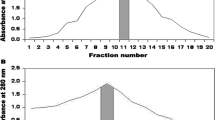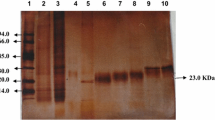Abstract
A cDNA clone encoding a novel lysophospholipase with a predicted molecular weight of 25.2 kDa was isolated from a Clonorchis sinensis adult cDNA library. The enzyme activity of the recombinant protein expressed in Escherichia coli was determined using phosphatidylcholine and lysophosphatidylcholine as substrates. Western blotting analysis indicated that it belonged to excretory/secretory proteins of the adults. The sensitivity and specificity of the recombinant antigen for serodiagnosis were evaluated with immunoglobulin enzyme-linked immunosorbent assay using serum samples from 20 patients with clonorchiasis and 20 patients with schistosomiasis. The sensitivity (75%) and specificity (80%) of the recombinant protein were comparable to those of crude extracts, at 65 and 82.5%, respectively. The sensitivity of the recombinant protein was 77% using 100 serum samples of clonorchiasis patients with various parasite burden. The results suggested that the recombinant lysophospholipase protein was not a satisfactory candidate for diagnosis of clonorchiasis, although it might be an excretory/secretory protein.





Similar content being viewed by others
References
Berrizbeitia M, Ndao M, Bubis J, Gottschalk M, Ache A, Lacouture S, Medina M, Ward BJ (2006) Purified excreted–secreted antigens from Trypanosoma cruzi trypomastigotes as tools for diagnosis of Chagas’ disease. J Clin Microbiol 44:291–296
Bhanot P, Schauer K, Coppens I, Nussenzweig V (2005) A surface phospholipase is involved in the migration of plasmodium sporozoites through cells. J Biol Chem 280:6752–6760
Brenner S (1988) The molecular evolution of genes and proteins: a tale of two serines. Nature 334:528–530
Cervi L, Rossi G, Masih DT (1999) Potential role for excretory–secretory forms of glutathione-S-transferase (GST) in Fasciola hepatica. Parasitology 119:627–633
Chen SCA, Wright LC, Golding JC, Sorrell TC (2000) Purification and characterization of secretory phospholipase B, lysophospholipase and lysophospholipase/transacylase from a virulent strain of the pathogenic fungus Cryptococcus neoformans. Biochem J 347:431–439
Choi MH, Park IC, Li S, Hong ST (2003) Excretory–secretory antigen is better than crude antigen for the serodiagnosis of clonorchiasis by ELISA. Korean J Parasitol 41:35–39
Chung YY, Ko RC (1999) A novel cDNA clone encoding a specific excretory/secretory antigen of larval Trichinella pseudospiralis. Parasitol Res 85:685–691
de Oliveira D, de Souza Tde A, Murate LS, Jankevicius JV, Gaziri LC, Jankevicius SI (2004) Protease and phospholipase inhibition protect Veneza zonata (Hemiptera Coreidae) against septicemia caused by parasite trypanosomatid 563DT. J Invertebr Pathol 85:9–17
Djordjevic JT, Del Poeta M, Sorrell TC, Turner KM, Wright LC (2005) Secretion of cryptococcal phospholipase B1 (PLB1) is regulated by a glycosylphosphatidylinositol (GPI) anchor. Biochem J 389:803–812
Ganga G, Varshney JP, Sharma RL (2006) Effect of Fasciola gigantica excretory secretory antigen on rat hematological indices. J Vet Sci 7:123–125
Ghannoum MA (2000) Potential role of phospholipases in virulence and fungal pathogenesis. Clin Microbiol Rev 13:122–143
Golan DE, Brown CS, Cianci CM, Furlong ST, Caulfied JP (1986) Schistosomula of Schistosoma mansoni use lysophosphatidylcholine to lyse adherent human red blood cells and immobilize red cell membrane components. J Cell Biol 103:819–828
Gross RW, Sobel BE (1983) Rabbit myocardial cytosolic lysophospholipase. Purification, characterization, and competitive inhibition by l-palmitoyl carnitine. J Biol Chem 258:5221–5226
Lee JS, Kim IS, Sohn WM, Lee J, Yong TS (2006) Vaccination with DNA encoding cysteine proteinase confers protective immune response to rats infected with Clonorchis sinensis. Vaccine 24:2358–2366
Li SY, Chung BS, Choi MH, Hong ST (2004) Organ-specific antigens of Clonorchis sinensis. Korean J Parasitol 42:169–174
Li Y, Zhang YH, Wang S, An XQ (2003) Assay for phospholipase A (PLA2) activity in microemulsions of by AOT water-isooctane. Journal of Nanjing Normal University (Natural Science Ed) 26:44–46
Lun ZR, Gasser RB, Lai DH, Li AX, Zhu XQ, Yu XB, Fang YY (2005) Clonorchiasis: a key foodborne zoonosis in China. Lancet Infect Dis 5:31–41
Lu T, Ito M, Tchoua U, Takemori H, Okamoto M, Tojo H (2001) Identification of essential residues for catalysis of rat intestinal phospholipase B/lipase. Biochemistry 40:7133–7139
Masamune A, Sakai Y, Satoh A, Fujita M, Yoshida M, Shimosegawa T (2001) Lysophosphatidylcholine induces apoptosis in AR42J cells. Pancreas 22:75–83
Pickard RT, Chiou XG, Strifler BA, DeFelippis MR, Hyslop PA, Tebbe AL, Yee YK, Reynolds LJ, Dennis EA, Kramer RM, Sharp JD (1996) Identification of essential residues for the catalytic function of 85-kDa cytosolic phospholipase A2. Probing the role of histidine, aspartic acid, cysteine, and arginine. J Biol Chem 271:19225–19231
Portilla D, Crew MD, Grant D, Serrero G, Bates LM, Dai G, Sasner M, Cheng J, Buonanno A (1998) cDNA cloning and expression of a novel family of enzymes with calcium-independent phospholipase A2 and lysophospholipase activities. J Am Soc Nephrol 9:1178–1186
Rao KV, He YX, Kalyanasundaram R (2003) Expression of a 28-kilodalton glutathione S-transferase antigen of Schistosoma mansoni on the surface of filamentous phages and evaluation of its vaccine potential. Clin Diagn Lab Immunol 10:536–541
Redmond DL, Knox DP (2006) Further protection studies using recombinant forms of Haemonchus contortus cysteine proteinases. Parasite Immunol 28:213–219
Sharp JD, Pickard RT, Chiou XG, Manetta JV, Kovacevic S, Miller JR, Varshavsky AD, Roberts EF, Strifler BA, Brems DN et al (1994) Serine 228 is essential for catalytic activities of 85-kDa cytosolic phospholipase A2. J Biol Chem 269:23250–23254
Sim S, Park GM, Yong TS (2003) Cloning and characterization of Clonorchis sinensis myoglobin using immune sera against excretory–secretory antigens. Parasitol Res 91:338–343
Sunaga H, Sugimoto H, Nagamachi Y, Yamashita S (1995) Purification and properties of lysophospholipase isoenzymes from pig gastric mucosa. Biochem J 308:551–557
Wang A, Dennis EA (1999) Mammalian lysophospholipases. Biochim Biophys Acta 1439:1–16
Wang A, Deems RA, Dennis EA (1997a) Cloning, expression, and catalytic mechanism of murine lysophospholipase I. J Biol Chem 272:12723–12729
Wang A, Loo R, Chen Z, Dennis EA (1997b) Regiospecificity and catalytic triad of lysophospholipase I. J Biol Chem 272:22030–22036
Wright LC, Payne J, Santangelo RT, Simpanya MF, Chen SC, Widmer F, Sorrell TC (2004) Cryptococcal phospholipases: a novel lysophospholipase discovered in the pathogenic fungus Cryptococcus gattii. Biochem J 384:377–384
Yang G, Yu XB, Wu ZD, Xu J, Song LX, Zhang HM, Hu XC, Zheng NC, Guo LC, Xu J, Dai JF, Ji CN, Gu SH, Ying K (2005) Molecular cloning and characterization of a novel adenylate kinase 3 gene from Clonorchis sinensis. Parasitol Res 95:406–412
Yamasaki H, Araki K, Lim PK, Zasmy N, Mak JW, Taib R, Aoki T (2000) Development of a highly specific recombinant Toxocara canis second-stage larva excretory–secretory antigen for immunodiagnosis of human toxocariasis. J Clin Microbiol 38:1409–1413
Zhang YY, Dennis EA (1988) Purification and characterization of a lysophospholipase from a macrophage-like cell line P388D1. J Biol Chem 263:9965–9972
Zheng BY, Feng YY, Xu JC, Zhang YH, An XQ (2005a) The effect of different factors on the specific activity of PLA2 in vesicle solution. Journal of Nanjing Normal University (Natural Science Ed) 28:77–79
Zheng N, Xu J, Wu Z, Chen J, Hu X, Song L, Yang G, Ji C, Chen S, Gu S, Ying K, Yu X (2005b) Clonorchis sinensis: molecular cloning and functional expression of novel cytosolic malate dehydrogenase. Exp Parasitol 109:220–227
Zhou L, Shi M, Guo Z, Brisbon W, Hoover R, Yang H (2006) Different cytotoxic injuries induced by lysophosphatidylcholine and 7-ketocholesterol in mouse endothelial cells. Endothelium 13:213–226
Acknowledgements
This work was supported by a grant from the key science and technique program of Guangdong province, China (No. 2004A30801004).
Author information
Authors and Affiliations
Corresponding author
Rights and permissions
About this article
Cite this article
Ma, C., Hu, X., Hu, F. et al. Molecular characterization and serodiagnosis analysis of a novel lysophospholipase from Clonorchis sinensis . Parasitol Res 101, 419–425 (2007). https://doi.org/10.1007/s00436-007-0481-3
Received:
Accepted:
Published:
Issue Date:
DOI: https://doi.org/10.1007/s00436-007-0481-3




